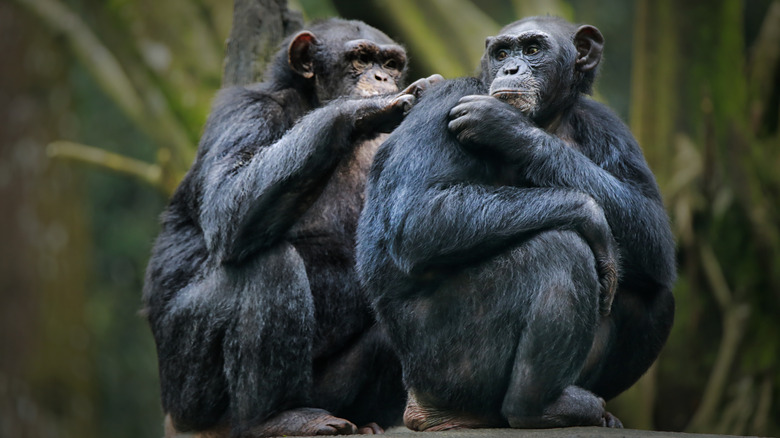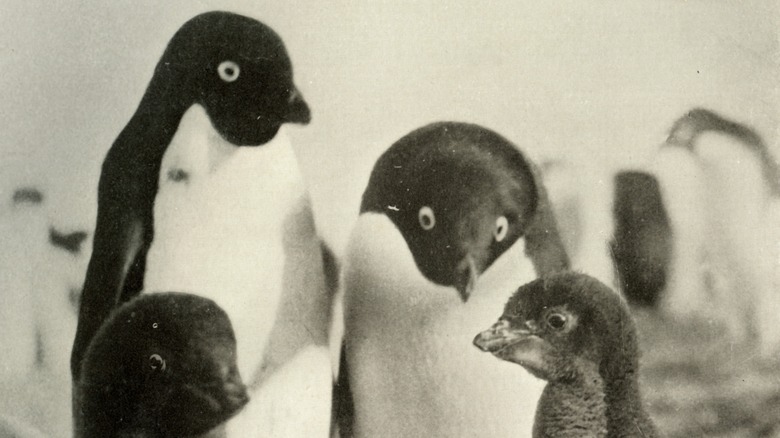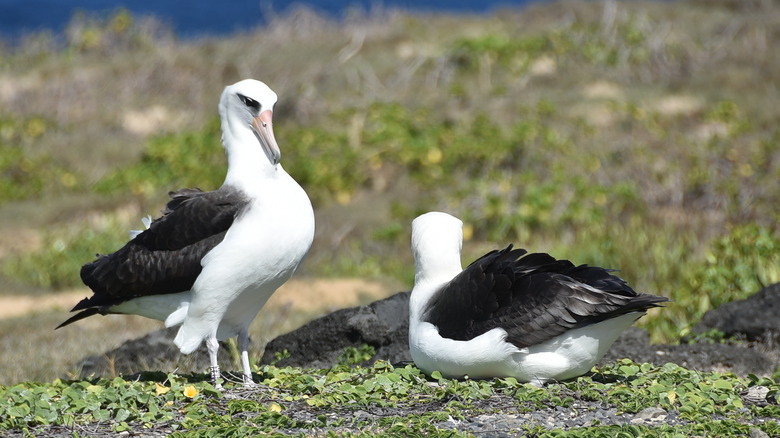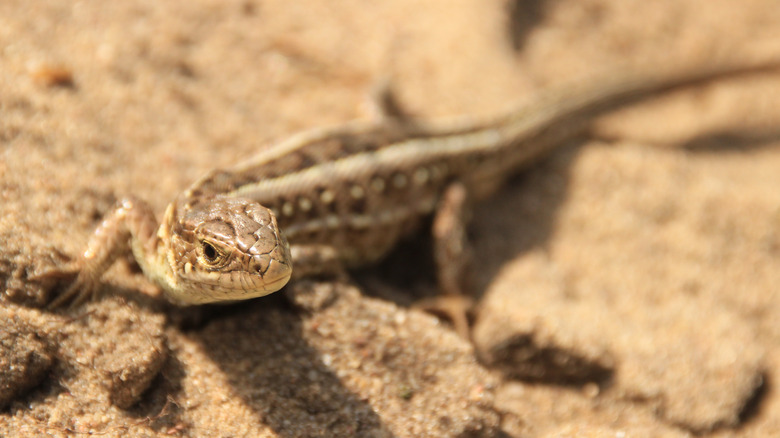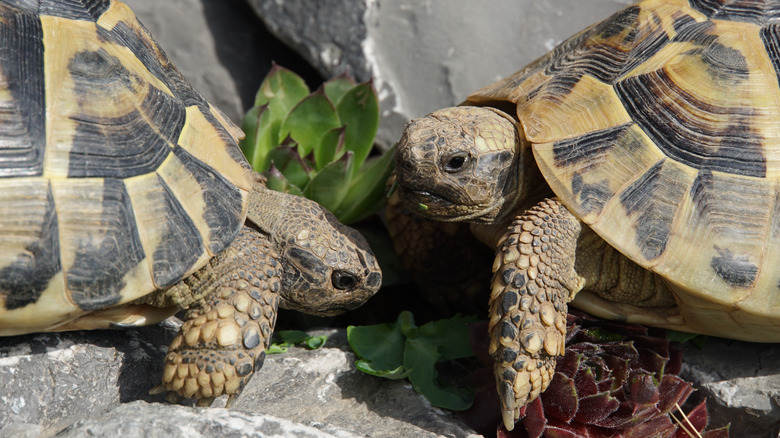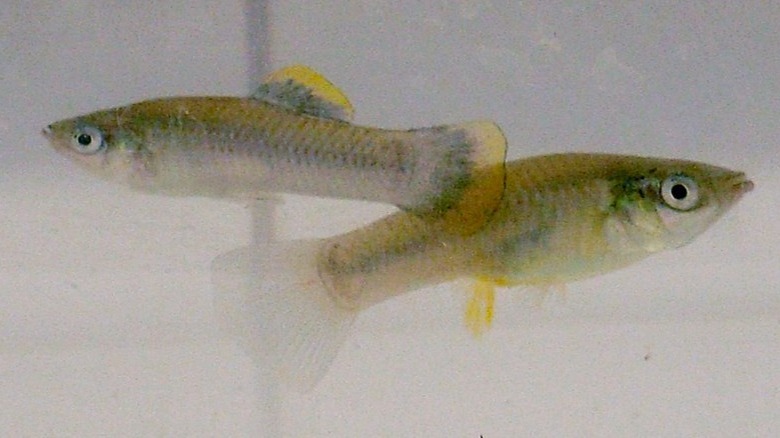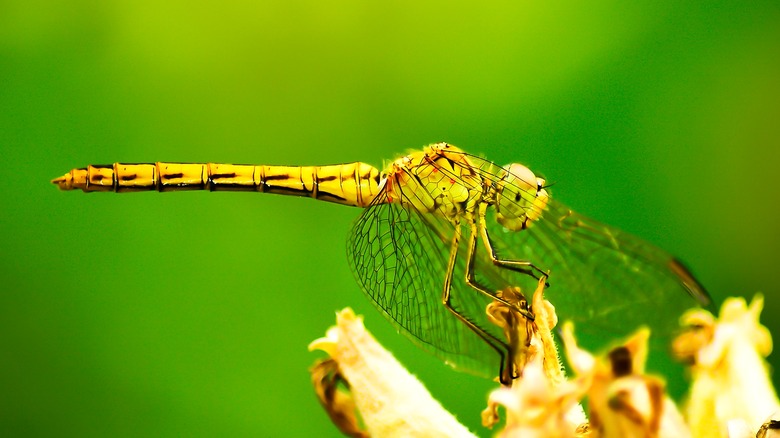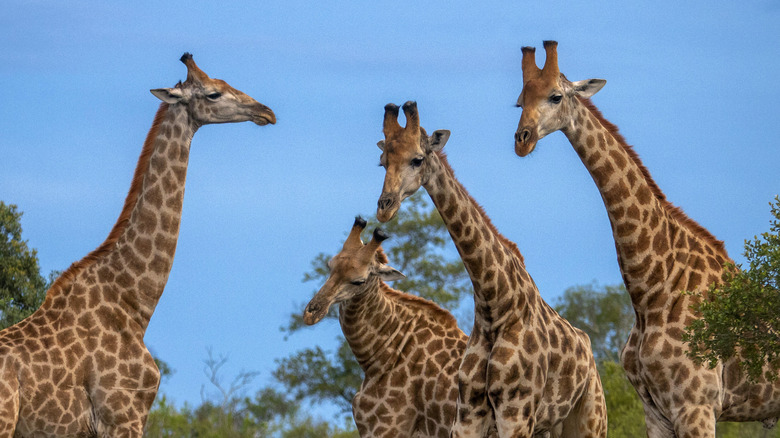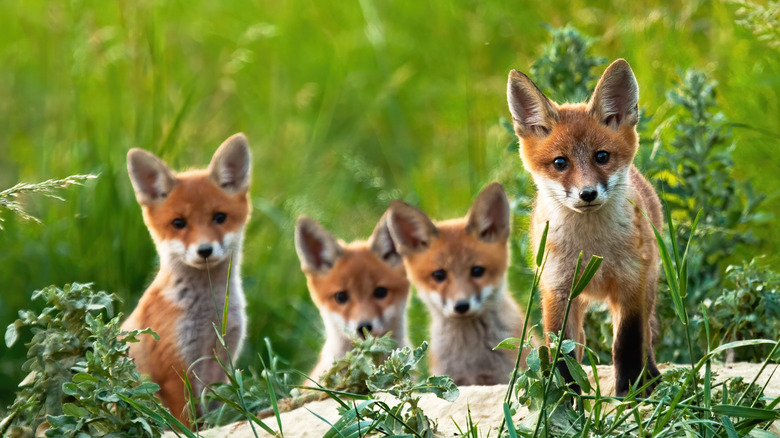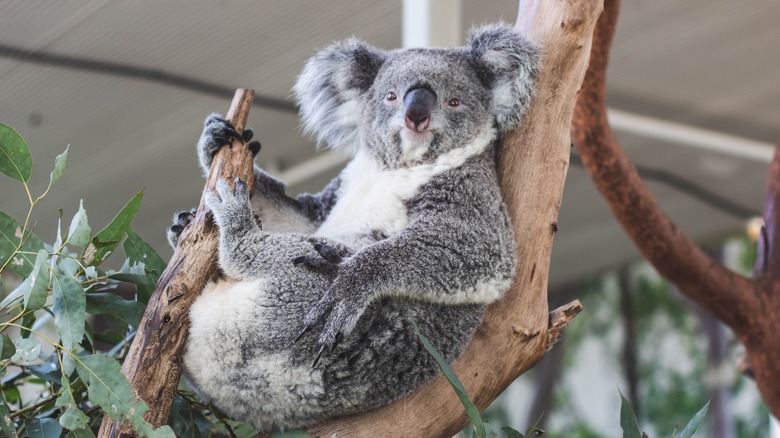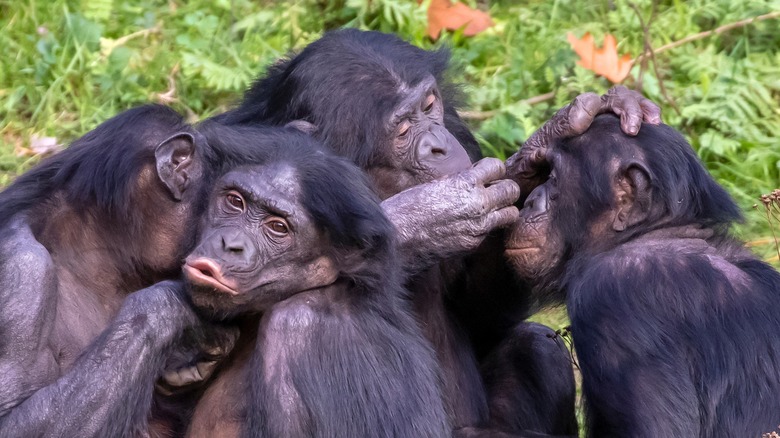Animal Species That Practice Same-Sex Coupling
That animals engage in myriad sexual behaviors has been known for a very long time, if not always gracefully acknowledged. According to Greenpeace UK, it was observations of same-sex coupling among male beetles that contributed to debates on homosexuality among scientists in the 1800s. While attitudes against queer behavior colored any such data from the animal kingdom — some findings were suppressed for a century — LGBTQ+ behavior in animals helped encourage some scientists to speak out against such prejudice in human society.
Same-sex coupling has been observed in every class of the animal kingdom. Greenpeace UK reports that nearly 1,000 animals display homosexual behavior, and Canadian biologist Bruce Bagemihl detailed 450 examples in his book "Biological Exuberance: Animal Sexuality and Natural Diversity" (via The Advocate). Besides sheer numbers, the range of sexual behaviors among animals is diverse and fascinating. Let's have a look at just a few examples.
Penguins
Penguins are among the better-known examples of same-sex coupling in the animal kingdom and one of the most observed over a long span of time. The British explorer George Murray Levick reported coupling among male Adélie penguins during the Scott Antarctic Expedition of 1910-13, according to The Guardian. Leverick was horrified, not only by the homosexuality but also by some males' tendency to kill chicks, coerce females, and attempt to mate with the dead (the latter behavior has since been explained as the behavior of confused, inexperienced males who mistake dead penguins with compliant mates). He chalked all of it up to hooliganism amongst the birds and restricted these observations to private papers kept within professional circles.
Levick's paper, "Sexual Habits of the Adélie Penguin," has since been made public and corroborated by later studies. And we now know that same-sex coupling, far from a horrific aberration of hooligan Adélies, is found in many penguin species. The museum studies program at Tufts University has collected news reports on chinstrap, Magellenic, Gentoo, King, Humboldt, and African penguins forming male-male and female-female couples in captivity. Both sexes invest in rearing young in the wild, and same-sex couples may seek to become parents. Zoos can enable adoptions of any excess eggs laid by heterosexual pairs — which doesn't entirely prevent egg thievery. That practice may go on in the wild, but it's difficult to know for certain when there's so little physical difference between the sexes of any penguin species.
Laysan Albatross
Monogamy is not unknown in the animal kingdom. Among the species that form lifelong couples is the Laysan albatross, according to Oceana. Pairs will return to the nesting grounds where they hatched to breed every one to two years. According to the Australian Broadcasting Corporation, the Laysan albatross can only lay one egg per breeding. There are no do-overs either; if an egg is lost, that's it for the couple that year. In the rare instances where a male bird is unfaithful, he may mate with a member of a female-female pair. Left with an egg, the females work together to raise their young.
Approximately 31 percent of chick-rearing pairs of albatrosses are made of two females, at least in the colony on Oahu, Hawaii observed for a 2014 study published in the Proceedings of the Royal Society B. These relations can endure for years just as heterosexual pairs can. As parents, female pairs can struggle; without a male to take over the first incubation shift, the laying female will need to immediately tend the egg without a chance to hunt for food. Still, female-female pairs manage to raise one chick every four years on average, and females who succeed as mothers in such pairs become more attractive to potential mates — male and female.
New Mexico Whiptail Lizard
The New Mexico whiptail lizard has been dubbed the "leaping lesbian lizard," according to the Guardian Liberty Voice. The name is a slight exaggeration. A hybrid species created by mating between the western whiptail and little striped whiptail, the New Mexico whiptail is exclusively female, a consequence of hybridization. Besides a coupling of members of the two parent species, the New Mexico whiptails can reproduce asexually. There's no fertilization required, and the chromosomes in the lizards' cells double before their eggs develop, allowing for genetic diversity among offspring (via National Geographic).
There may be no need for a male to fertilize the eggs, but that doesn't mean that New Mexico whiptails forego sexual activity. A 1980 study published in the Proceedings of the National Academy of Sciences of the United States of America observed females who were not reproductively active mounting females who were. The purpose of this behavior remained an open question at the time of the study, but more recent research (via the BBC) has found that the mounting females are driven by a surge of testosterone, providing stimulation to induce ovulation in their partner.
Hermann's Tortoise
Some sexual behavior in animal species can be driven by a disproportionate ratio of males to females. A study published in 2016 in Behavioral Ecology examined the mating behaviors of an isolated population of Hermann's tortoises on Golem Grad Island, Macedonia, for seven years. There were over 1700 tortoises on Golem Grad, but the landscape of the island separated the population into two groups — one concentrated on the shoreline and the other on the island's plateau. For reasons unknown to the researchers, both populations skewed heavily toward male individuals, with the plateau subpopulation having only 5% adult females.
In such an environment, same-sex coupling was not rare, particularly in the plateau subpopulation. Male tortoises were observed to court one another, issue mating calls, and engage in mounting behavior. Approximately 74% of sexual activity among the plateau tortoises was between males, compared with 33% among the shoreline population. The females were not observed to pursue members of either sex, and in a typical mating scenario for the species, they will attempt to escape and even flip over pursuers before accepting mounting.
Atlantic Molly
Same-sex coupling can be found under the sea among many species, though the purpose of such behavior among certain animals isn't always straightforward. The Atlantic molly is a freshwater fish from Mexico. A 2013 study published by the Royal Society's Biology Letters looked at the mating behaviors of laboratory-reared mollies. Other observations had found that females of other types of mollies were more attracted to males they saw mating, even if it was with females of another species. The researchers wanted to see if subordinate male mollies who engaged in same-sex coupling could increase their attractiveness to the opposite sex.
The practice of mating with an individual observed to have mated with another partner is known as mate choice copying. The Atlantic molly was chosen for the study for its particularly promiscuous mating rituals, distinguished by nipping at the genital area and a marked preference by females for larger, more colorful males. Smaller male mollies also display regular homosexual behavior, possibly due to being cut off from shoals of females by more dominant males in the wild. But under the controlled conditions of the study, same-sex coupling by subordinate males did indeed inspire mate choice copying among females, at only slightly lower rates than heterosexual coupling.
Dragonflies
Most studies on homosexual behavior in the animal kingdom have focused on birds and mammals, according to Live Science. Nevertheless, the insect world hasn't been entirely neglected. Researchers out of Tel Aviv University and the Swiss Federal Institute of Technology collaborated on a review of studies into homosexuality among insects in 2013, with an admittedly narrow focus on male-male coupling. Within that framework, they found plenty of evidence of homosexual activity, but not of the most romantic kind. With insect evolution driving most species to fast mating encounters, most same-sex coupling among males seems to be an accident of haste.
Causes of accidental male-male mating include mistaking other males (or inanimate objects) with females or the lingering scent of previous sexual encounters. The frequency with which this behavior occurs in the wild is unknown; most of the studies collected for the review were done in the laboratory. But there is an estimated range for at least one species. According to The Guardian, 20% to 80% of male dragonflies demonstrate evidence of male-male encounters. Unfortunately for the dragonflies, the evidence isn't the most pleasant. Male insect anatomy isn't designed for same-sex encounters, and the sign of such an encounter in a dragonfly is cloacal damage from the pinchers of another male.
Orcas
Among the species discussed in biologist Bruce Bagemihl's "Biological Exuberance: Animal Homosexuality and Natural Diversity" is the orca. Despite being popularly known as the killer whale, orcas are part of the dolphin family, and they can be far more affectionate and sociable than their nickname suggests. They organize into matrilines, which are family groups centered around the mother. The matriarch will have her children — male and female — around her and possibly members of her own family or the previous generation. Matrilineal groups that socialize and communicate together form larger societies known as pods.
When pods of orcas come together for feeding during the summer and fall, the males will often temporarily break apart from their families to form sex-exclusive gangs. In these groups, homosexual activity is not uncommon. Between one-third and one-half of male orcas engage in same-sex coupling at some time in their lives, most often in adolescence (via "Biological Exuberance"). Their courtship of one another can last a few minutes or a few hours and involve quite elaborate displays of affection.
One mating ritual engaged in by same-sex and heterosexual coupling is the beak-genital orientation, where partners will take turns nuzzling each other's belly and genital areas with their snouts. The receiving orca stays near the surface of the water, occasionally rising up to breathe until both animals spin downward together before switching roles. Most same-sex encounters among orcas are reciprocal, and some couples will form lifelong bonds, engaging in mating behavior together every year.
Giraffes
"Ninety percent of giraffes are gay." This was the claim made by Dawn Butler, then the shadow secretary for women and equalities, in October 2019 (via The Guardian). The remark was intended as praise for a school program that encouraged acceptance of homosexuality, but it brought on a fierce response from Lachlan Stuart, senior domestic policy advisor to then-Labour leader Jeremy Corbyn. Stuart considered the comparison to giraffes homophobic, on the grounds that what Butler took as same-sex coupling was actually dominance behavior. It was among the stranger inter-party feuds Labour has gone through. Nevertheless, squabbling politicians are not the best judges of animal behavior.
Giraffes live in loose herds without close bonds between members. Males are transient and usually maintain distance from one another. Asked by The Guardian to weigh in on the matter of male-male giraffe sex, director of the Giraffe Conservation Foundation Stephanie Fennessy noted that male interaction that appears like same-sex coupling is often a dominance display. Like dogs, giraffes may mount one another to assert authority. They will also lock necks in combat, which can be fatal.
Necking isn't always a violent behavior, however. In the same article as Fennessy's comments, Dr. Natalie Cooper of the Natural History Museum said that these interactions can go together with sexual coupling. Safari guide Jody Cole has commented that the neck battles have a bonding component for males, and even females will sometimes engage one another in this manner.
Red Foxes
Wolves are well-known for their pack behavior and dogs for their loyalty to their owner, but other members of the canine family can also be sociable animals. According to Bruce Bagemihl's "Biological Exuberance," fox foxes have a highly variable society, with the most common type of group being made of related females (vixens) and at least one male. In these family groups, a female in heat will inspire attraction from her companions of both sexes. Whoever's mounting her, the breeding vixen often responds with bared teeth, snarling, and boxing. The excitement brought on by her state can spread through the group as well, with younger vixens mounting one another and engaging in playful, rasping calls. Depending on their position within the hierarchy of a group, some vixens will remain drawn to other females for their entire life, while males will often opt to couple with one another over subordinate females.
Vixens may engage in sexual behavior with one another, but they can also come together to co-parent. They'll bring each other food, take turns nursing each other's pups, and cooperate to raise those pups to adulthood. These parents are often related females, but unrelated vixens will also become joint mothers. It's a more common practice among subordinate members of a group, up to 70% of whom will never leave to start families of their own with a male (per "Biological Exuberance").
Koalas
Same-sex coupling in the animal kingdom can stem from confusion, the absence of the opposite sex, or natural attraction and social bonding needs. It seems that human activity can affect animal mating behaviors as well. According to The Independent, bringing koalas into captivity can have a marked effect on the sexual inclinations of females, and only females.
Wild koalas seem to be exclusively heterosexual, but their captive female cousins will have three same-sex couplings for every one with males. The preference is so marked that a female who rejects a male suitor will become receptive to another female who approaches right after. Multiple koalas may partake of sexual activity at once, and researchers observed one "sex session" involving five of them.
Why female koalas favor same-sex coupling in captivity is uncertain. The University of Queensland scientists interviewed by the Independent offered theories ranging from a desire to attract males to a way to relieve stress.
Bonobos
If any animal can be said to embody the plea "make love, not war," it may well be the bonobo. Our closest animal relatives along with chimpanzees (per Live Science), bonobos have remarkably strong social bonds. They've picked up the nickname "the hippie ape" for their generally equal treatment of the sexes, their tendency to cooperate and share food, and for their sexual promiscuity (via Medical News Today). Bonobos have sex for reproduction, for fun, to bond, and to resolve conflicts with one another. The latter purpose seems to do the job well: quite unlike their close cousin, the chimpanzee (and humans), bonobos have never been observed to kill one another.
Bonobos frequently engage in heterosexual and homosexual activity. Even infants will partake, and they seem to have an instinct for sex even when orphaned and cut off from adult bonobos to learn from. It seems that same-sex coupling is more common among females than males, however. Based on observational studies and analysis of oxytocin levels in urine samples, scientists have speculated that females find same-sex activity more pleasurable than sex with male bonobos. Coupling with other females also seems to create stronger social bonds and allows them to cooperate and maintain relatively equal footing with the males.
